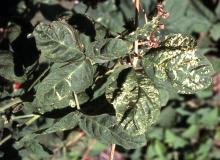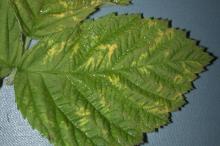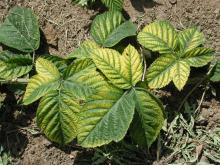See:
Raspberry (Rubus spp.) - Crumbly Fruit
Raspberry (Rubus spp.) - Viruses
Blackberry Cultivar Susceptibility
Cause Many viruses have been found in blackberries in the Pacific Northwest. Blackberry calico virus (a carlavirus) is universally present in older commercial 'Thornless Loganberry' fields. Despite no know vector (other than grafting or vegetative propagation of infected plants) the disease spreads rapidly in the field. Similar calico diseases occur in field-run 'Marion', 'Chehalem', 'Olallie', and 'Waldo' blackberries. Other virus diseases known to infect blackberries in the Pacific Northwest include strawberry necrotic shock virus, (SNSV) an ilarvirus transmitted by unknown means, and raspberry bushy dwarf virus (RBDV), which infects pollen and is therefore transmitted by insect pollenators. RBDV was found in 4 of 32 fields surveyed in 2000. SNSV is transmitted by thrips in strawberry and there is some evidence it can be transmitted by thrips to Rubus spp. since there can be low levels of transmission in plants that are not flowering. Strawberry necrotic shock virus and raspberry bushy dwarf virus can be detected serologically.
Other viruses, of lower importance, that can infect blackberry include apple mosaic virus. There are at least 12 additional viruses that are common in the Southeastern US in blackberry. Each of those viruses is symptomless in single infections, so laboratory testing must be carried out to ensure that these viruses are not introduced into the PNW.
Symptoms Usually no definite symptoms are observed. Symptoms are quite variable depending on cultivar and virus combination. Degree of crumbliness or druplet abortion can range from severe to very mild. Yellow line patterns are common on plants infected with blackberry calico virus (almost as if painted on with a fine brush) and general chlorosis in plants of 'Marion' blackberry infected with raspberry bushy dwarf virus (as if painted on with a sprayer). Strawberry necrotic shock virus (usually symptomless alone) or blackberry calico virus cause minor impacts on fruit yield and quality. Raspberry bushy dwarf virus in 'Marion' causes bright yellowing of the leaves on primocanes and a bleaching of leaves on fruiting canes in July and August. Chlorosis has not been observed early in the season. A 50% yield reduction and 40% reduction in fruit size and druplet number have been measured. Since the receptacle stays with the fruit, the crumby berry symptom is not observed. No reduction in cane diameter or length was observed. RBDV in mixed infections with BRNV and/or blackberry calico virus can cause drupelet abortion and misshapen fruit, though it has been much less of a problem in blackberry than in red raspberry.
Cultural control A control program for blackberry viruses must begin with nursery stocks propagated from virus-indexed sources known to be fruitful. Such sources are commercially available.
- Use certified planting stock.
- Plant immune or resistant cultivars if available.
- Plant in large blocks to slow movement of pollenborne viruses into new plants, especially if fields in the immediate area are infected.
- Test for nematodes before planting and do not plant in soil containing Xiphinema spp.
Reference Martin, R.R., MacFarlane, S., Sabanadzovic, S., Quito, D., Poudel, B., and Tzanetakis, I.E. 2013. Viruses and virus diseases of Rubus. Plant Disease 97:169-182.



